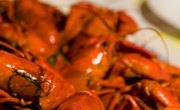
The Red River is located in northern New Mexico and offers fishing for wild and stocked trout. Most of the fish in the river are less than 16 inches long, but larger fish from the Rio Grande use the river for spawning. The river also has a small population of resident fish more than 16 inches long. Conventional and fly-fishing tackle are effective and all anglers are encouraged to practice catch-and-release in the river. The Red River has special trout regulations from the New Mexico Department of Game and Fish and only two trout longer than 12 inches can be kept each day.
Step 1
Obtain a fishing license through a sporting goods store or license vendor. Fishing licenses for New Mexico can be purchased for one day, five days or a year. People over 70 years of age can fish for free and juniors, seniors and handicapped people receive a discount.
Step 2
Use chumming techniques only if you are fishing on the Gila River before the confluence of the East Fork, the Rio Grande River below the confluence with the Chama River or in a general warm water fishery. Chumming is illegal in all trout waters.
Step 3
Abide by the special trout water regulations when fishing the Red River, Red River City Ponds and Red River Hatchery Pond. The Red River allows a bag limit of two trout over 12 inches long. The hatchery and city ponds have a bag limit of three trout in any length. All anglers must stop fishing when the bag limit has been reached.
Step 4
Do not fish in the east Red River City Pond unless you are handicapped or less than 12 years old. Fish the ponds between March 1 and Nov. 15. The ponds are closed to fishing during the winter months.
Step 5
Keep up to five black bass, 15 catfish, 20 crappie, 10 pike, five walleye, 25 white bass, 30 yellow perch, one tiger muskie and 20 bluegill each day. The bag limits apply to all warm waters in the state of New Mexico.
References
Writer Bio
Zach Lazzari is a freelance outdoor writer specializing in hunting, fly fishing and the general outdoors. He guided fly fishing trips for 10 years in Colorado, Alaska, Montana and Patagonia-Chile. Zach lives in Montana and splits time between the river and keyboard.


